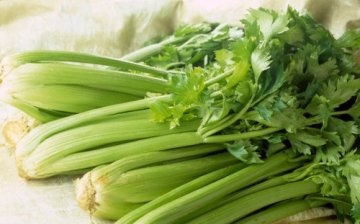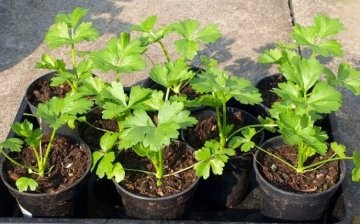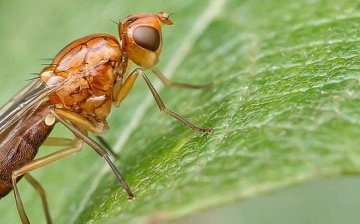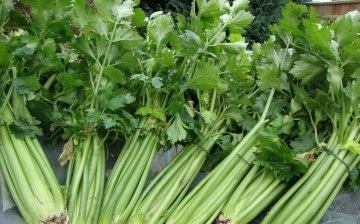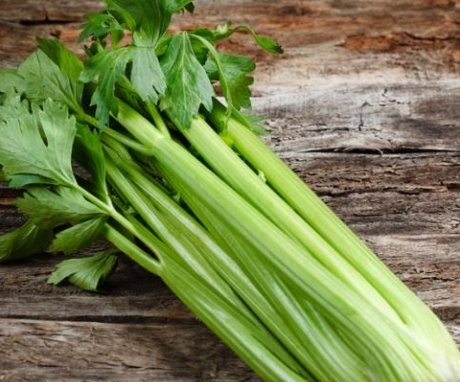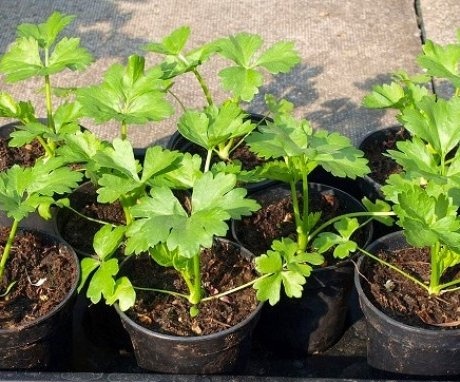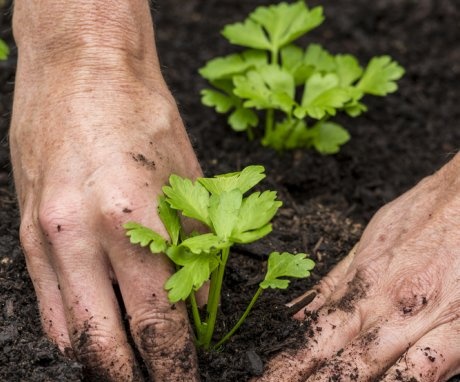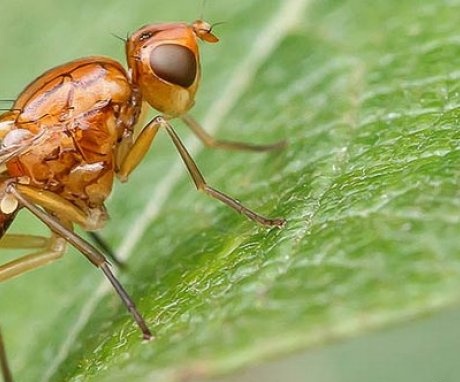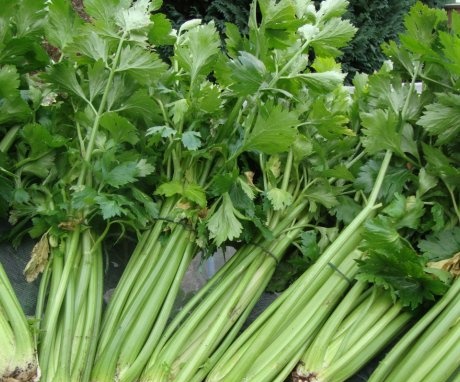Growing stalked celery seedling method
Spicy cultures occupy a special place in human life. Due to the content of odorous substances in them, they give dishes a specific taste, and also have a positive effect on the human body. Healing properties celery used in folk medicine for a long time. To grow it on your site, you need to know about the features of planting a herbaceous plant, caring for it.
Celery has three varieties - leaf, petiole, root. In the petiole species, thick long stems have a pleasant taste, which are used to prepare salads. The successful cultivation of a vegetable consists in the application of the seedling method technology, in observing the rules of caring for it.
Content:
- Petiole celery: description of the species, medicinal properties
- Growing seedlings of an odorous plant
- Terms and rules for transplanting seedlings into open ground
- Celery Care Tips
- Diseases and pests of spicy herbs
- Harvesting, storage methods
Petiole celery: description of the species, medicinal properties
Celery belongs to the biennial plants of the Umbrella family. In the first year, you can use the juicy stalks for cooking, and in the second year, pick fruits with seeds. The herbaceous plant at the top of the thick fleshy stem has feathery light green leaves with a specific aroma.
Petioles emerge from a strong taproot, acquiring a whitish tint over time. Under favorable conditions, at the end of summer or another year, small white flowers are formed on the stems, collected in complex umbrellas. After ripening, seed pods appear. They can be planted with the expectation that their germination will improve with increasing age. After lying for two to three years, the seeds will sprout faster.
The stalks of stalked celery contain a large amount of vitamins and essential oils.
Therefore, they are used for the preparation of culinary, canned products, medicines. Fresh juice obtained from vegetable stalks is taken as a diuretic, pain reliever. It effectively removes water from the body, but pregnant women, people with kidney inflammation should not drink it. Lotions from the leaves of the plant help in the treatment of ulcers, wounds.
Celery is irreplaceable in the fight against obesity. In salads, it goes well with carrots, turnip, dill... And plant juice can be mixed with carrot juice, honey. Celery will help to improve sleep, calm down. For men, it is a prophylactic agent, restraining the appearance of the inflammatory process in the prostate gland. Although petioled celery is less popular than leaf celery, its stems add an unforgettable taste to dishes and help to cope with many ailments.
Growing seedlings of an odorous plant
The seedling method of growing stalked celery is preferable, as the plant may not reach maturity in areas with short summers. The growing season of a vegetable reaches two hundred days. Planting seeds begins with preparatory work.In early March, containers for seedlings are prepared, filling them with a mixture of garden soil and humus. You can add a little river sand to increase the looseness of the soil.
Caring for stalked celery seedlings is not difficult, but will help them grow efficiently in the garden.
Before planting, the seeds are soaked in a solution of Immunocytophyte, leaving in it for a day. This will increase their resistance to diseases, accelerate germination. Celery seeds are laid out on the surface of the earth, moistened with water on top. The boxes with planting material are covered with a film on top, placed in a warm place with good lighting... It is necessary to ventilate the seedlings daily and water the ground with water at room temperature as the top layer dries.
Seedlings will germinate in seven to ten days, then the shelter is removed. As soon as two or three leaves appear, seedlings diveremoving weak and pale shoots. You can feed seedlings once every two weeks using mineral complexes... In this case, one must not forget that, once on the leaves, the nutrient solution can cause burns. When the sprouts are faded, the seedlings are watered with urea - half a gram per liter of water. Two weeks before planting celery seedlings in open ground, they begin to harden, lowering the air temperature to 15 degrees Celsius.
Terms and rules for transplanting seedlings into open ground
The main indicator of transplanting celery into the garden is the external condition of the sprouts. They must have a strong root system, reach a length of at least fifteen centimeters. In this case, the age of the seedlings reaches sixty days. Seedlings are planted after good soil warming, when the threat of frost has passed.
The best place for celery is in slightly shaded areas with moist and nutritious soil.
Therefore, it is advisable to add manure or compost to the vegetable growing site in the fall. The culture grows well after garden plants such as pumpkin, cabbage, tomato, zucchini... When planting it in the place of carrots, parsley, it will give weak yields.
Seedlings are planted at a distance of half a meter from each other, since the petioled variety of culture gives a lush bush. The juiciness of the plant, its useful qualities depend on the timing of transplanting seedlings into open ground.
Celery Care Tips
The main requirements for caring for a petiole plant include the following:
- Water the celery often, more abundantly than carrot and parsley, but no more than four times a month. To retain moisture, you can sprinkle the soil around the bushes with a layer of sawdust mulch, without filling the place where the root passes into the stem.
- The vegetable beds are fed two or three times per season with ammonium nitrate, superphosphate, potassium salt. Dilute minerals in water, ten to thirty grams per bucket, gently pouring celery bushes.
- With sufficient thickening of the petioles, hilling is carried out, well loosening the earth, pulling out weeds. At the same time, the root collar cannot be covered.
- To rid the stems of bitterness a month before harvest, they are covered with soil high. From this, the petioles become whitish due to the lack of exposure to ultraviolet radiation. You can tie cardboard to the stems to the leaves, or put dark plastic bottles on them. From this procedure, celery will not taste bitter, it will delight you with a delicate pleasant taste.
Taking care of a well-rooted vegetable is not difficult, following simple recommendations.
Diseases and pests of spicy herbs
Of the diseases of stalked celery, fungal ones are especially distinguished:
- White rot is manifested by the appearance of a light gray mycelium with black blotches on parts of the plant. You can avoid the disease by neutralizing the acidity of the soil by adding slaked lime.
- Leaves and stems, covered with rust spots, become completely dark brown by autumn. They lose their useful qualities and taste. For the treatment and prevention of the disease, spraying with drugs such as Fitosporin is used.
- Septoriosis affects the plant at the end of summer, manifesting itself with a large number of small yellow spots on the leaves, oval brown spots on the petioles. Disease can be prevented by disinfecting seeds, cured by spraying with Fundazole solution.
- In a cold, damp summer, brown spots appear on the roots. This develops scab, its prevention is to change the place of planting.
- The cucumber mosaic virus slows down the growth and development of the vegetable. It is difficult to fight him, you will have to destroy the infected shoots. The infection is carried by insects - pests of celery.
- Borshchevichnaya boleworm is noticed by the whitish oval eggs, which it lays inside the leaves. The larvae that appear bore through the leaf plates, damaging them. The onion planted next to the celery repels the harmful fly.
- After wintering in conifers, the larvae of the carrot lice move to celery bushes. In this case, the stems of the plant slow down in growth, the leaves are curled.
- Carrot flies severely damage the petioles of the grass. It is necessary to fight pests by treating the aisles with tobacco dust mixed with dry mustard. You can cope with them with insecticides such as Actellik.
For the prevention of diseases and the attack of harmful insects, it is necessary to follow the rules of agricultural technology of celery, carefully destroying weeds, deeply digging up areas under the vegetable.
Harvesting, storage methods
Petiole celery must be removed before the fall frosts. You should not rush too much, because staying in the ground longer, it will retain its juiciness and taste longer. A month before harvesting, young side shoots with leaves are removed. Celery ripens at the end of September. Then they begin to pull it out of the ground, trying not to damage the stems. The tops are then cut, sorting out the rotten and damaged parts.
For later storage, the stems are left in a well-ventilated area or outdoors under a canopy.
If you are going to store a vegetable in the refrigerator, then the peeled and dried petioles are placed in a cellophane bag or wrapped in foil. Likewise, the freshness of the plant will last for a month.
The chopped celery seasoning is prepared after the chopped shoots are well dried. This takes about thirty days. After passing them through a blender, place the powder in jars. Salting celery stalks is carried out as follows: they are folded tightly into a jar, covered with salt. Two hundred grams of salt are taken per kilogram of vegetable. Canned food is stored rolled up in a cool place. Timely removing the vegetable from the garden, you can feast on dishes with the addition of celery all winter.
More information can be found in the video:



